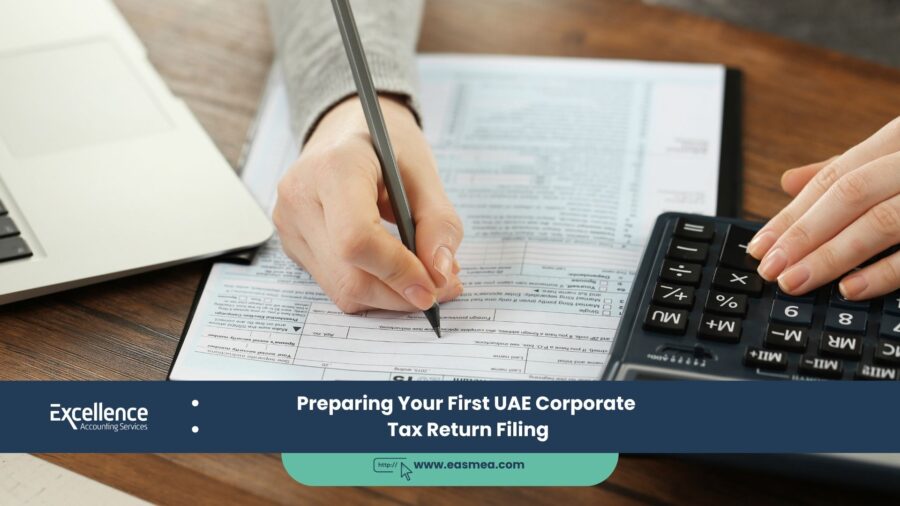Preparing Your First UAE Corporate Tax Return Filing
The moment of truth for UAE businesses has arrived. After months of preparation, understanding legislation, and adjusting internal processes, the first Corporate Tax (CT) return filing deadline is approaching for many. This inaugural filing is more than a procedural step; it’s a critical milestone that will set the standard for a company’s relationship with the Federal Tax Authority (FTA). For business owners and finance teams, this first return can seem daunting, filled with new terminology, complex calculations, and the pressure to get everything right from the very beginning.
- Preparing Your First UAE Corporate Tax Return Filing
- Part 1: The Preparatory Phase - Laying the Groundwork
- Part 2: The Calculation - From Book Profit to Taxable Income
- Part 3: The Filing Process - Using the EmaraTax Portal
- What Excellence Accounting Services (EAS) Can Offer
- Frequently Asked Questions (FAQs)
- Ensure Your First Tax Filing is Flawless.
This guide is designed to demystify the process and provide a clear, actionable roadmap for preparing and submitting your first UAE Corporate Tax return. We will walk through the essential preparatory phases, from confirming your tax period to organizing your financial statements. We will break down the crucial journey from your accounting profit to your final taxable income, explore the practical steps of using the EmaraTax portal, and highlight the common pitfalls that can lead to errors and penalties. With a structured approach, your first tax filing can be a smooth and compliant process, not a source of stress.
Key Takeaways for Your First CT Return
- Know Your Deadlines: The return must be filed within 9 months of the end of your financial year. Missing this deadline incurs penalties.
- Start with Audited Financials: Your audited financial statements are the starting point for calculating taxable income. All businesses should maintain them.
- Taxable Income ≠ Accounting Profit: You must make several adjustments to your book profit (e.g., for non-deductible expenses) to arrive at the final taxable income.
- Documentation is Everything: Every number on your return must be backed by clear, organized documentation, from invoices to contracts and financial reports.
- EmaraTax is the Gateway: All filings must be completed and submitted electronically through the FTA’s EmaraTax portal.
Part 1: The Preparatory Phase – Laying the Groundwork
Long before you log into the EmaraTax portal, the most critical work for a successful tax filing is done. Proper preparation is the key to accuracy and efficiency.
Step 1: Confirm Your Tax Period and Filing Deadline
The first step is to be absolutely certain of your company’s first tax period. This is determined by your financial year.
- If your financial year is 1 Jan – 31 Dec, your first tax period is 1 Jan 2024 – 31 Dec 2024. Your filing deadline is 30 September 2025.
- If your financial year is 1 Jun – 31 May, your first tax period is 1 Jun 2023 – 31 May 2024. Your filing deadline is 28 February 2025.
Missing this deadline is not an option. The FTA imposes penalties for late filing, so mark this date clearly in your corporate calendar.
Step 2: Ensure Your Financial Statements are in Order
Your tax return begins with your company’s financial statements. These statements must be prepared in accordance with internationally accepted accounting standards (like IFRS). While not all companies are legally required to have their statements audited, it is a non-negotiable best practice for corporate tax purposes. An audited statement provides a verified, credible starting point for your tax calculation and is the single most important piece of documentation. This requires diligent, year-round accounting and bookkeeping.
Step 3: Gather All Supporting Documents
Beyond the main financial statements, you need a comprehensive file of supporting documents. This includes, but is not limited to:
- Detailed trial balance and general ledger.
- Fixed asset register with depreciation calculations.
- Schedules for all major expenses, especially those with specific deduction rules (e.g., entertainment).
- Loan agreements and interest calculation schedules.
- Invoices for all major transactions and capital expenditures.
- Transfer pricing documentation, if applicable.
A thorough account reconciliation service can ensure these underlying records are accurate and complete.
Part 2: The Calculation – From Book Profit to Taxable Income
This is the most technical part of the process. Your taxable income is rarely the same as the net profit shown on your income statement. You must make a series of adjustments to bridge this gap.
| Adjustment Type | Explanation | Example |
|---|---|---|
| Add Back Non-Deductible Expenses | Expenses recorded in your books that are not allowed as deductions for tax purposes must be added back to your profit. | Adding back 50% of client entertainment costs, or 100% of fines and penalties. |
| Deduct Exempt Income | Income included in your P&L that is exempt from UAE Corporate Tax must be subtracted. | Subtracting qualifying dividends or capital gains received from a participating interest. |
| Apply Reliefs | Utilize specific tax reliefs available under the law to reduce your taxable income. | Applying Small Business Relief (if eligible) or utilizing previous years’ tax losses. |
| Transfer Pricing Adjustments | Ensure all transactions with Related Parties are at arm’s length, adjusting income/expenses if they are not. | Increasing sales revenue if goods were sold to a sister company at a below-market price. |
Each of these adjustments requires a deep understanding of the law. For example, mastering the rules around deductible expenses is crucial for this stage. A miscalculation here can have a significant impact on your final tax liability.
Part 3: The Filing Process – Using the EmaraTax Portal
Once your taxable income is calculated and all your documents are ready, the final step is to submit the return via EmaraTax, the FTA’s digital tax service platform.
- Login and Access the CT Return: Log in to your EmaraTax account. The corporate tax return form will be available under your user profile.
- Enter Financial Information: You will be required to input key figures from your financial statements.
- Declare Adjustments: The form will guide you through the process of making the book-to-tax adjustments discussed in Part 2. You will need to input the values for non-deductible expenses, exempt income, etc.
- Attach Required Documents: The portal will prompt you to attach your financial statements and may require other supporting schedules.
- Review and Submit: Carefully review all the information entered. The portal will automatically calculate your tax liability based on the figures you provided. Once you are confident everything is accurate, you can digitally sign and submit the return.
- Payment: After filing, you must pay the calculated tax liability by the deadline to complete the process.
The Indispensable Role of Technology
Attempting to manage this process with manual spreadsheets is a recipe for disaster. A modern, UAE-compliant accounting software is essential. A platform like Zoho Books helps automate much of this work. It ensures your bookkeeping is accurate throughout the year, can generate the necessary financial reports, and provides a clear audit trail for every transaction. An expert accounting system implementation can configure your software to align with CT requirements, making the year-end reporting process significantly smoother.
What Excellence Accounting Services (EAS) Can Offer
Your first Corporate Tax return is a critical compliance milestone. Don’t navigate it alone. The experts at EAS provide end-to-end support to ensure your filing is accurate, timely, and optimized.
- Tax Return Preparation and Filing: We handle the entire process for you—from calculating your taxable income to preparing all schedules and submitting the final return on your behalf through our expert UAE Corporate Tax services.
- Financial Statement Preparation: Our team ensures your financial statements are IFRS-compliant and ready for tax purposes, supported by our robust financial reporting capabilities.
- Pre-Filing Review and Audit: We conduct a pre-submission review of your calculations and documentation through our internal audit service to identify and mitigate any potential red flags before you file.
- Strategic Tax Planning: Our CFO services go beyond compliance, helping you plan for future tax periods and structure your business for optimal tax efficiency.
- Representation with the FTA: Should any queries arise from your filing, we can act as your tax agent and liaise with the FTA on your behalf.
Frequently Asked Questions (FAQs)
You must file your tax return and pay the tax due within 9 months following the end of your relevant financial year. For a company with a calendar year-end of 31 December 2024, the deadline is 30 September 2025.
Yes. A corporate tax return must be filed for every tax period, even if the business incurred a tax loss or if its taxable income is below the AED 375,000 threshold. Filing a return is mandatory for all taxpayers registered for Corporate Tax.
The primary document required is your audited (or unaudited, if applicable) financial statements for the tax period. The FTA may also request other supporting documents and schedules through the EmaraTax portal, depending on the complexity of your return.
If you discover an error after filing, you should submit a voluntary disclosure to the FTA as soon as possible to correct the mistake. Proactively correcting errors can help mitigate potential penalties. It’s better to be transparent than to wait for the FTA to discover the error.
Currently, the UAE Corporate Tax Law does not contain a provision for the automatic extension of the filing deadline. Businesses are expected to meet the statutory deadline. Therefore, planning and starting the preparation process early is essential.
The FTA imposes administrative penalties for non-compliance. There will be penalties for the late filing of the tax return and separate penalties for the late payment of the tax due. The exact amounts will be specified in Cabinet Decisions.
Your financial statements must be prepared in accordance with either the International Financial Reporting Standards (IFRS) or IFRS for SMEs. Consistency in applying these standards is key.
Payment is made through the EmaraTax portal. You can use the GIBAN (Generated International Bank Account Number) provided on the portal to make a bank transfer or use other e-payment options available on the platform.
Yes. Even if you are eligible for and elect to apply for Small Business Relief, you are still required to register for Corporate Tax and file a tax return. However, the return may be a simplified version. The requirement to file is not waived.
While it is not legally mandatory, it is highly recommended, especially for your first return. The complexity of the law, the importance of accuracy, and the significant penalties for non-compliance make professional assistance from a certified tax agent a prudent investment.
Conclusion: Setting the Precedent for Compliance
Your first UAE Corporate Tax return is a foundational event. It establishes your compliance track record with the FTA and embeds crucial financial disciplines into your business operations. By taking a proactive, organized, and well-documented approach, you can navigate this process smoothly. Preparation, precision in calculation, and leveraging the right professional support are the key ingredients for a successful filing that not only meets your legal obligations but also strengthens your company’s financial governance for the years to come.



